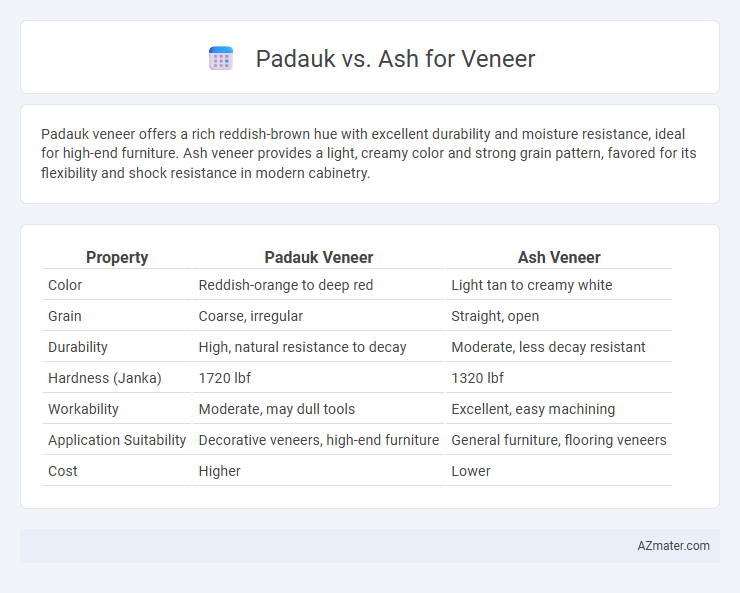Padauk veneer offers a rich reddish-brown hue with excellent durability and moisture resistance, ideal for high-end furniture. Ash veneer provides a light, creamy color and strong grain pattern, favored for its flexibility and shock resistance in modern cabinetry.
Table of Comparison
| Property | Padauk Veneer | Ash Veneer |
|---|---|---|
| Color | Reddish-orange to deep red | Light tan to creamy white |
| Grain | Coarse, irregular | Straight, open |
| Durability | High, natural resistance to decay | Moderate, less decay resistant |
| Hardness (Janka) | 1720 lbf | 1320 lbf |
| Workability | Moderate, may dull tools | Excellent, easy machining |
| Application Suitability | Decorative veneers, high-end furniture | General furniture, flooring veneers |
| Cost | Higher | Lower |
Introduction to Padauk and Ash Veneer
Padauk veneer is renowned for its vibrant reddish-orange hues and exceptional durability, making it a popular choice for high-end furniture and decorative applications. Ash veneer offers a lighter, creamy beige tone with a straight, pronounced grain pattern known for its strength and flexibility, ideal for contemporary and rustic designs. Both veneers provide unique aesthetic and structural benefits, with Padauk excelling in striking color contrast and Ash prized for its consistent texture and resilience.
Origin and Botanical Differences
Padauk, primarily sourced from tropical regions of Africa and Southeast Asia, belongs to the Pterocarpus genus, characterized by its brightly colored reddish-orange heartwood and distinctive grain patterns. In contrast, Ash, native to temperate zones of North America and Europe, comes from the Fraxinus genus, known for its light color, straight grain, and hard, dense wood. Botanically, Padauk is a leguminous hardwood with nitrogen-fixing capabilities, while Ash is a deciduous wood renowned for its shock resistance and elasticity, making each veneer suitable for different aesthetic and functional applications.
Color and Appearance Comparison
Padauk veneer showcases vibrant reddish-orange hues that deepen to a rich, dark red over time, creating a striking visual impact ideal for bold design choices. Ash veneer features a lighter, more neutral palette with creamy to pale brown tones and pronounced, straight grain patterns that impart a clean, modern aesthetic. The choice between Padauk's warm, dynamic coloration and Ash's subtle, elegant appearance depends on the desired style and ambiance in interior applications.
Grain Patterns and Texture
Padauk veneer features a distinctive interlocking grain pattern that creates a bold, visually striking surface, while Ash veneer exhibits a straight, uniform grain delivering a more subtle and consistent appearance. The texture of Padauk is smooth yet dense, providing durability alongside its vibrant reddish-orange hue, contrasting with Ash's lighter color and slightly coarse, open texture that highlights its natural, earthy character. These differences make Padauk ideal for statement pieces with dynamic visual impact, whereas Ash suits applications requiring a classic, clean, and organic look.
Durability and Hardness
Padauk veneer is known for its exceptional durability and hardness, making it highly resistant to wear, dents, and scratches, ideal for high-traffic areas and furniture that endures heavy use. Ash veneer, while also durable, is generally softer and less resistant to impact, suitable for applications where moderate toughness with enhanced flexibility is preferred. The Janka hardness rating of Padauk typically exceeds 1700, compared to Ash's rating of around 1320, highlighting Padauk's superior strength and longevity in veneer applications.
Workability and Finishing Qualities
Padauk veneer offers excellent workability with its fine, straight grain, making it easy to cut and sand while producing a smooth finish that enhances its vibrant reddish-orange hues. Ash veneer is prized for its flexibility and strength, allowing for precise shaping and a consistent, even surface that readily accepts stains and finishes to highlight its light, creamy color. Both veneers respond well to finishing treatments, but Padauk's natural oils may require sealing to ensure uniform finish adherence.
Cost and Availability
Padauk veneer tends to be more expensive than Ash veneer due to its exotic origins and limited availability, often sourced from tropical regions in Africa and Asia. Ash veneer is widely available in North America, making it more cost-effective and easier to procure for large projects. Both woods offer unique aesthetic qualities, but budget-conscious buyers often prefer Ash for its affordability and consistent supply.
Environmental Impact and Sustainability
Padauk veneer comes from Pterocarpus species, which are often sourced from tropical regions experiencing deforestation, making sustainable harvesting practices critical to minimize environmental damage. Ash veneer, typically derived from Fraxinus species, is more commonly harvested from temperate forests with established sustainable forestry management programs, resulting in a lower carbon footprint and better regeneration rates. Choosing ash veneer supports sustainable forest management and reduced ecological impact, while padauk veneer's vibrant appearance requires careful sourcing to prevent contributing to habitat loss and biodiversity decline.
Best Applications for Padauk Veneer
Padauk veneer, known for its vibrant reddish-orange hue and exceptional durability, excels in high-end furniture, decorative paneling, and musical instruments where aesthetic appeal and wear resistance are critical. Its natural resistance to decay and insect attacks makes it ideal for indoor applications in humid environments. Compared to ash, which offers a lighter color and pronounced grain suitable for flooring and sports equipment, padauk's striking color and stability are best showcased in veneers requiring both visual impact and lasting performance.
Ideal Uses for Ash Veneer
Ash veneer is prized for its light color, distinctive grain pattern, and excellent workability, making it ideal for furniture, cabinetry, and interior paneling where a clean, natural look is desired. Its durability and resistance to wear make it suitable for high-traffic areas and functional surfaces like flooring and staircases. Compared to the reddish hue and denser texture of Padauk veneer, Ash offers a more versatile and subtle aesthetic that complements modern and traditional designs.

Infographic: Padauk vs Ash for Veneer
 azmater.com
azmater.com